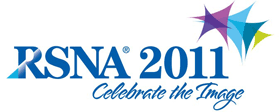
Abstract Archives of the RSNA, 2011
Ethan J. Halpern MD, Presenter: Research grant, Koninklijke Philips Electronics NV
Research grant, Lantheus Medical Imaging, Inc
Equipment support, Toshiba Corporation
Dinesh Kumar Sharma MD, Abstract Co-Author: Nothing to Disclose
Achala Donuru MD, Abstract Co-Author: Nothing to Disclose
Adrian T Estepa, Abstract Co-Author: Nothing to Disclose
We evaluated the impact of prospective ECG-gating with axial CT angiography using "step and shoot" mode on image quality and effective radiation dose during pulmonary CT angiography.
Retrospective review identified 50 CT scans performed for the clinically suspected diagnosis of pulmonary embolism during a 3-month period, including 25 cases performed with prospective ECG-gated axial CT angiography and 25 cases performed with conventional non-gated helical CT angiography. All scans were performed on the 256 slice iCT scanner (Philips Medical Systems) at 120kVp. Axial scans were performed with 60cc of contrast material while helical scans were performed with 100cc of contrast material (350mg/ml). Contrast enhancement levels and image noise were quantified with a standardized 2cm2 region of interest in the main pulmonary artery. Subjective image quality was rated by two blinded observers on a 1-5 subjective scale based upon clarity and enhancement of the pulmonary segmental and subsegmental vessels. Effective radiation dose was computed from the reported dose length product. Statistical comparisons between prospective ECG-gated axial CT angiography and conventional helical CT angiography were performed with a rank-sum test or t-test as appropriate.
Patients scanned with prospective ECG-gated axial CT angiography had a slightly higher body mass index (34.8 vs 32.8; p=0.8 - not statistically significant) and greater image noise (standard deviation = 43 vs 24 Hounsfield units; p<0.01). Mean image quality as rated by the subjective score was improved with prospective ECG-gated axial CT angiography (4.2 vs 3.4; p<0.001). Effective radiation dose was significantly lower among patients scanned with prospective ECG-gated axial CT angiography as compared with conventional non-gated helical CT angiography (4.7 vs 11.5mSv; p<0.001).
Effective radiation dose of pulmonary CT angiography is reduced by more than 50% with prospective ECG-gated axial CT angiography as compared to conventional helical CT angiography. Subjective image quality of pulmonary CT angiography was improved with ECG-gated scanning due to sharper visualization of vascular structures, even though image noise as measured quantitatively was slightly higher.
Prospective ECG-gated axial CT angiography can provide improved image quality with a lower effective radiation dose as compared with conventional helical CT angiography.
Halpern, E,
Sharma, D,
Donuru, A,
Estepa, A,
Evaluation for Pulmonary Embolism Using Prospective ECG-gating: Impact on Image Quality and Effective Radiation Dose. Radiological Society of North America 2011 Scientific Assembly and Annual Meeting, November 26 - December 2, 2011 ,Chicago IL.
http://archive.rsna.org/2011/11004400.html

